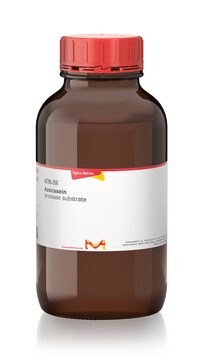PF0100
Protease Fluorescent Detection Kit
high sensitivity assay
Sinónimos:
Protease Assay Kit
About This Item
Productos recomendados
Aplicación
- in the detection of proteolytic activity using casein based protease assay
- for testing the extracellular proteolytic activity of fungal strains
- for quantifying mitochondrial protease activity
- for measuring the protease production from soil solution
Idoneidad
Cantidad
The trichloroacetic acid (TCA) component is provided as 6.1 N TCA solution. 0.6 N TCA Solutions may be prepared by a 10-fold dilution of the desired volume of T0699 with ultrapure water. It is not necessary to dilute the entire volume of T0699 for immediate use of the kit.
Nota de análisis
Solo componentes del kit
- Incubation buffer 25 mL
- FITC-casein solution 5 mL
- Assay buffer 200 mL
- Protease standard (trypsin) 20 μg
- FITC control 50 mg
- Trichloroacetic acid (TCA) solution 30 mL
Palabra de señalización
Danger
Frases de peligro
Consejos de prudencia
Clasificaciones de peligro
Aquatic Acute 1 - Aquatic Chronic 1 - Eye Dam. 1 - Resp. Sens. 1 - Skin Corr. 1A - Skin Sens. 1 - STOT SE 3
Órganos de actuación
Respiratory system
Código de clase de almacenamiento
8A - Combustible corrosive hazardous materials
Punto de inflamabilidad (°F)
Not applicable
Punto de inflamabilidad (°C)
Not applicable
Certificados de análisis (COA)
Busque Certificados de análisis (COA) introduciendo el número de lote del producto. Los números de lote se encuentran en la etiqueta del producto después de las palabras «Lot» o «Batch»
¿Ya tiene este producto?
Encuentre la documentación para los productos que ha comprado recientemente en la Biblioteca de documentos.
Los clientes también vieron
Protocolos
The Protease Fluorescent Detection Kit provides ready-to-use reagents for detecting the presence of protease activity. This simple assay to detect protease activity uses casein labeled with fluorescein isothiocyanate (FITC) as the substrate.
Nuestro equipo de científicos tiene experiencia en todas las áreas de investigación: Ciencias de la vida, Ciencia de los materiales, Síntesis química, Cromatografía, Analítica y muchas otras.
Póngase en contacto con el Servicio técnico











